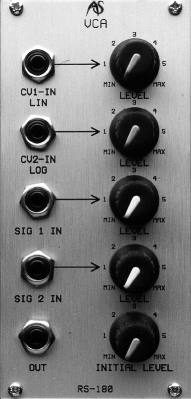RS180
Logarithmic And Linear VCA
In principle, amplifiers have a simple job - they just amplify or attenuate the signals presented to them.
Voltage controlled amplifiers (VCAs) are more sophisticated because they allow you to control the amount of amplification or attenuation by applying a voltage to a CV input. Such VCAs exist in every synthesiser that demonstrates the ability to shape a sound. You may think that it's the envelope that is, for example, changing the volume, but it isn't. The envelope is producing a CV that, when applied to the VCA, causes it to modify the signal passing through it. The VCA is one of the fundamental modules that allow us to make sounds develop over time.
Of course, VCAs need not be restricted to simply amplifying audio signals. Other basic configurations include modulating a VCA using a Low Frequency Oscillator to produce the effect known as tremolo. In sophisticated instruments, the speed and depth of the LFO can themselves be controlled by a VCA, so that the rate and intensity of the tremolo changes in time too.
IN USE
CV Inputs
Dual CV inputs allow you to control the VCA from a wide range of
sources. The CV1-IN LIN input responds linearly to incoming CVs, while
the CV2-IN LOG input responds logarithmically. A graphic showing the
differences between these is presented overleaf.
Traditional wisdom suggests that linear CV inputs are most useful for LFOs, whereas you should use the logarithmic response for envelopes. There is some basis for this, but you must remember that any signals can be presented to the CV inputs. Furthermore, both CV inputs may be used simultaneously, allowing you to create complex VCA responses.
Initial
Level
The INITIAL LEVEL does what it says: with no CVs applied to either CV input,
it determines the gain of the VCA. Therefore, with the INITIAL LEVEL
set to MAX and with no negative CVs applied to the CV inputs, the RS180
will pass signals with no changes in amplitude. At the other extreme, with
the INITIAL LEVEL set to MIN and with no positive CVs applied to the CV
inputs, the RS180 will pass no signals whatsoever.
If CVs fluctuating around 0V are presented to the CV inputs, the VCA gain will be modulated around the INITIAL LEVEL.
Inputs and
Outputs
There VCF has two inputs: SIG 1 IN and SIG 2 IN, each with an associated
LEVEL control. The RS180 incorporates a mixer so that the signals
presented to these can be treated simultaneously.
The inputs accept both audio signals and CVs in the range ±10v. The LEVEL controls offer unity gain in the fully clockwise position, and completely attenuate the signal at their anticlockwise extreme.
There is a single output that carries a signal in the range ±10v.
